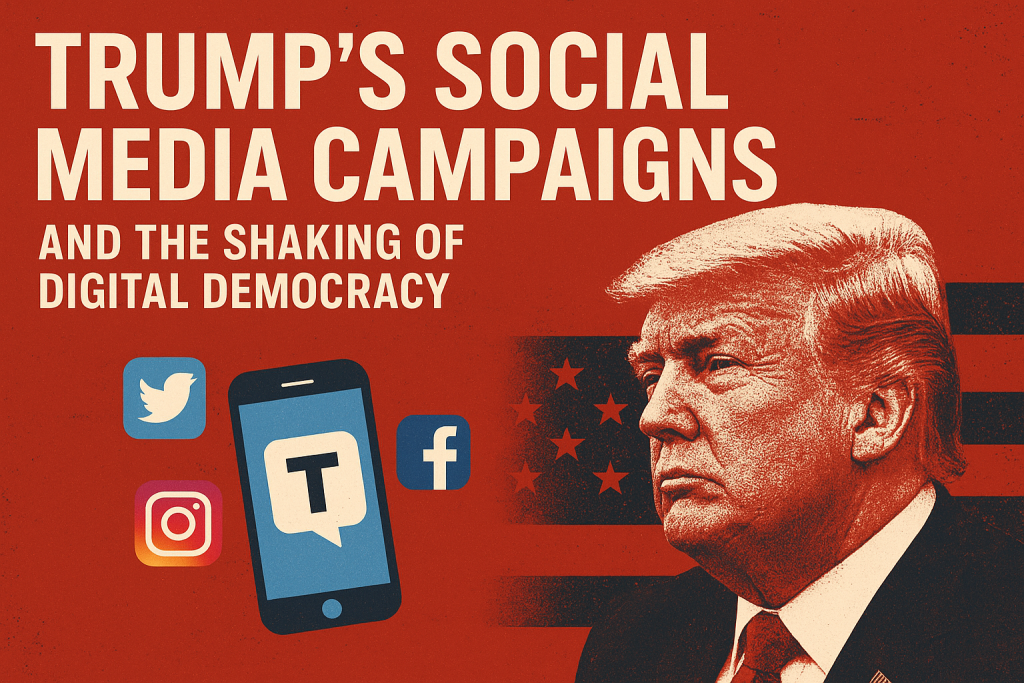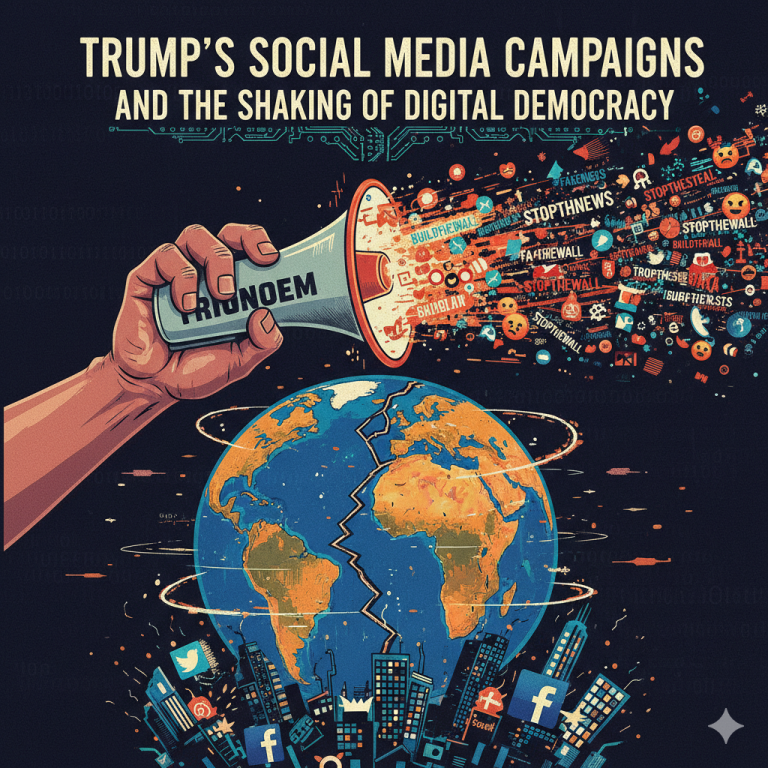Donald Trump didn’t just run for office — he rewrote the rules of political communication in the digital age. What began as viral tweets and provocative messaging in 2016 has evolved into a fully diversified, alt-tech ecosystem centered on direct, emotionally charged content.
I’ll compare the 2016 and 2024 phases of Trump’s social media strategy, showing how the tactics, technology, and tone shifted — and what those changes reveal about the fragility and future of democratic discourse in a hyperconnected world.
We’ll begin with the 2016 “digital dynamo” era and Cambridge Analytica, then pivot to Trump’s 2024 playbook of alt-tech platforms, content warfare, and narrative control.
Cambridge Analytica and the Microtargeting Machine
The Data Harvest
In the lead-up to 2016, Cambridge Analytica (CA) built a reputation as a secret weapon for data-driven campaigns. At the heart of its approach was a Facebook app quiz — “This Is Your Digital Life,” built by Aleksandr Kogan — that harvested data not just from the respondents, but from their Facebook friends too. This method allowed CA to pull in data on tens of millions of users, reportedly touching 87 million Facebook profiles. Wikipedia
The campaign claimed CA used this massive trove to assemble psychographic profiles (personality traits, values, emotional tendencies) on U.S. voters. From there, the idea was to serve ultra-targeted messages designed to tap into specific fears, values, or vulnerabilities.
CA was helmed by CEO Alexander Nix, in cooperation with key political operatives (notably the Mercer family and Steve Bannon) who funneled pro-Trump Super PAC money into data operations. Newsweek
Internal documents later revealed CA’s highly segmented ad blueprint, showing how thousands of variant ads were deployed across platforms to test and refine messaging in real time. The Guardian

Psychographic Profiling and Microtargeting
The core selling point of CA’s model was the use of psychographic segmentation: instead of generic demographic categories (age, gender, location), messages could be tailored to people who scored highly in traits like “neuroticism,” “openness,” or “conscientiousness.” The goal: appeal to underlying motivations and emotional impulses, rather than surface-level cues.
In practice, that meant different voters would see different versions of ads or messaging about immigration, safety, or leadership — sometimes subtly shifting tone, imagery, or framing. The hope was to nudge persuasion margins in swing states by targeting soft or persuadable voters with customized nudges.
This approach was not limited to the U.S. — CA claimed involvement in the Brexit referendum and other campaigns with similar microtargeting tactics. The Guardian
The Aftermath and Regulatory Wake-Up Call
Once the scandal broke, public backlash was swift:
- The U.S. Federal Trade Commission (FTC) imposed a $5 billion fine on Facebook in July 2019, partly over lax third-party data sharing practices. Wikipedia
- In the U.K., the Information Commissioner’s Office (ICO) fined Facebook £500,000 (the maximum under law at that time). Wikipedia
- The #DeleteFacebook movement gained traction, with many users and critics demanding stronger data protections.
In response, Facebook instituted tighter restrictions on third-party apps, limited the accessible data fields for external developers, and increased transparency and labeling requirements for political ads. Wikipedia
Nevertheless, the incident exposed a gaping regulatory void: the tools for political persuasion had outpaced the rules governing them.
The 2024 Landscape: Banishment, Alt-Tech, and a New Narrative
The Ban and the Platform Shift
After the January 6 Capitol riots in 2021, Trump was banned from major platforms like Twitter, Facebook, and YouTube. saisreview
In response, he launched Truth Social — a bespoke platform designed to insulate him from what his team called “mainstream censorship.” With its controlled environment, it became his primary megaphone. Though his account on X (formerly Twitter) was later reinstated, Truth Social remains the core hub for his direct messaging and mobilization. saisreview
This shift signaled a turning point: from leveraging Big Tech’s reach (with heavy data support) to owning an ideological and infrastructural platform.
The Content Strategy: Aggressive and Emotional
In 2024, Trump’s messaging leaned harder into confrontation, escalation, and affect. The tone is unapologetic:
- Provocative / Confrontational — calling out enemies directly, framing discourse as warfare
- Emotional appeals — fear, grievance, victimhood, outrage
- Simplicity and repetition — short, punchy phrases reinforce identity and group boundaries
His choice of issues also sharpened: trade wars, border security, inflation, cultural conservatism, anti-establishment grievances, immigration, and so on — all risk issues for his base.
He presents multiple personas simultaneously:
- Only Leader to Restore Law & Order
- Most Resilient President in History
- Expert Businessman Outsider
- Persecuted Political Victim
These overlapping identities allow flexibility in messaging and help embed him among core supporters.
The Core Narratives (The “Us vs. Them” Strategy)
Trump’s 2024 messaging is threaded by a few persistent narratives:
- “Stolen / Rigged 2020 Election” — a contestation of legitimacy that serves both as grievance and call to action.
- “51 Intelligence Agents” claim — a plot framing the “deep state” as part of the conspiracy.
- Mainstream Media as Democrat Propaganda — delegitimizing traditional sources of information.
- Dehumanization of opponents — labeling them “crooked,” “incompetent,” and “stupid.”
- Embrace of fringe theories (e.g. QAnon) — signaling ideological alignment with the fringes.
His fundraising messages mirror this tone: “I am Your Retribution,” “They are coming for me — donate now,” “Biden’s Border Invasion,” etc. The use of his mugshot from the Georgia case as a fundraising image is a textbook example of turning vulnerability into a rallying symbol.

Channel and Audience Expansion
To reach a broad and ideologically aligned audience, Trump’s campaign in 2024 layered multiple distribution channels:
- Truth Social as hub
- Rumble, Telegram, GETTR and other alt-tech venues
- Meta & Google Ads (despite his issues with Big Tech)
- SMS & Email blasts — direct, permissioned messaging
- Merchandise & physical branding
- Cross-post amplification via sympathetic media outlets and influencers
His targeted audience included working-class Americans, rural conservatives, and even Gen Z — pushing content formats (short videos, memes, viral content) to reach younger voters. thehilltoponline
Bringing in Spending: How Much Did It Cost?
No campaign runs without data on budgets, and comparing spending helps clarify priorities.
2016 (Rough Context)
While exact public breakdowns of how much Trump spent specifically on Cambridge Analytica–led data operations are opaque, the campaign did rapidly increase digital and data spend in the closing months.
- In September 2016, Trump’s campaign spent ~$70 million combined on ads, data, and outreach — more than doubling the prior monthly expenditures. The Washington Post
- Reports at the time noted that Trump, though historically data-skeptical, began pouring “millions on data and digital services” as Election Day neared. PBS
- Cambridge Analytica itself is estimated to have earned around $16.1 million from Republican committees across the 2016 cycle. The Influence Industry Project
Thus, while the data operation was not the largest line item, it was a critical lever behind ad targeting and message optimization.
2024 (More Transparent Figures)
By 2024, more data is publicly available:
- Trump’s 2024 campaign reports show that 66.54% of its expenditures went to media — approximately $313.84 million out of the total. OpenSecrets
- Fundraising, administrative, research, and other categories soak up the rest. OpenSecrets
- Across Google and Meta alone, $619 million was spent on political advertising by August 2024 (across all campaigns) — including $248 million oriented to the presidential race. Brennan Center for Justice
- By the end of the cycle, $1.35 billion was spent in total on political ads on Google and Meta, with more than half of that spend occurring in just the final two months. OpenSecrets
- The overall ad projections for 2024 suggested that total U.S. presidential ad spending might reach $12.3 billion(across all media) — a 24% increase over 2020. Solomon Partners
- Despite this, analysts noted that Trump’s social media ad spend in 2024 was lower relative to past cycles, reflecting the shift toward content, owned platforms, and organic reach. EMARKETER
- On Meta platforms, the combined campaigns of Biden, Harris, and Trump were responsible for over 6 billion ad impressions in 2024. SU News
These numbers highlight a shift: whereas in 2016 the value was in microtargeted spend and data ops, in 2024 the scale and media dominance remained essential — but changing attention to narrative, owned channels, and amplification over pure paid reach.
5. Conclusion: The Digital Legacy
Trump’s transformation from a data-driven disruptor in 2016 to a content-driven alt-tech powerhouse in 2024 reflects a broader shift in political campaigning:
- 2016: Secretive microtargeting, psychographic profiling, and behind-the-scenes data operations
- 2024: Loud, direct, emotionally resonant messaging across platforms he (or his team) controls
What does this evolution mean for democracy?
- Data privacy will remain a perpetual battleground. The Cambridge Analytica scandal blew open Pandora’s box, but newer tools (AI, real-time behavioral tracking) only deepen the risks.
- Alt-tech ecosystems will proliferate. As mainstream platforms exert control, political actors will gravitate to ideological safe harbors and create parallel architectures.
- Populist, emotional, confrontational rules the algorithm. Engagement incentives favor outrage, identity affirmation, and division — not deliberation.
- The playbook has changed globally. Many emerging campaigns now mimic this template: build owned platforms, generate friction on systemic issues, push narratives, and weaponize grievance.
In the decades ahead, the question will not be “Who wins the presidency?” but “Which side controls the architecture of discourse — the pipes, the platforms, and the persuasion engines?” Trump’s digital strategy may be flawed or dangerous, but it has undoubtedly redefined the rules of political engagement forever.


2 Responses
very well wrote, amazing.
great analysis of trump’s social media campaigns .